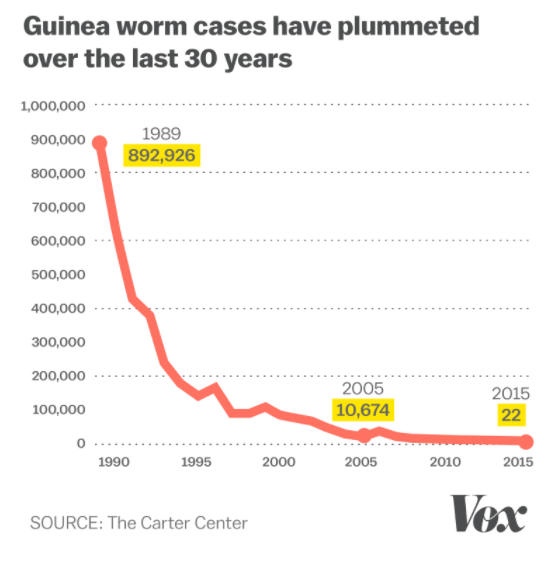7 deadly diseases the world has (almost) eradicated

It has been 35 years since the World Health Organization declared that smallpox had been eradicated. Image: REUTERS/Babu
It’s easy to feel pessimistic about the health of the world’s population. Growing antibiotic resistance, the dramatic rise in obesity related diseases and problems associated with an ageing population are all cause for concern.
But how about the diseases that mankind is winning the fight against? The truth is, we are on the brink of eradicating a string of deadly diseases that were, until recently, affecting millions of people.
It has been 35 years since the World Health Organization declared that smallpox had been eradicated. Now there are hopes that similar declarations will be made about a number of other killer diseases in the coming years.
Caused by a parasite caused dracunculiasis which means “affliction with little dragons” in Latin, Guinea worm is exceedingly painful and can be permanently debilitating, especially in children.
The worm, which spreads via dirty drinking water, can destroy the muscles and tissue surrounding a knee or inside a foot leaving young children unable to walk for the rest of their lives.

In 1986 there were 3.5 million cases of Guinea worm reported globally. By 2015, that was down to 22 cases and so far in 2017, there have been only 3 individual cases reported.
According to the The Carter Center, Guinea worm “is set to become the second human disease in history, after smallpox, to be eradicated.”
Like smallpox, measles is highly contagious. Its most serious complications include blindness, severe diarrhea, serious respiratory infections and encephalitis, an infection that causes brain swelling.
Measles can also have a crippling long-term effect on children's immune systems, leaving them susceptible to other infectious diseases. This makes the measles vaccine even more important.
Aside from localized outbreaks associated with parents refusing vaccinations for their children, measles has been largely eliminated in most affluent countries, and deaths from measles across the globe have dropped by 75% since 2000.
While the virus is still common in many developing countries, particularly in parts of Africa and Asia, the WHO hopes to eliminate the disease globally by 2020.
Mumps is a contagious disease that typically causes the salivary glands in the cheeks and jaw to swell. While most cases do not cause lasting damage, it can result in severe complications that include encephalitis or meningitis, swelling of the ovaries or breasts and deafness.
Before children in the US started getting routinely vaccinated against mumps (the “MMR vaccine” is typically given in two doses and is 97% effective against mumps, measles, and rubella), it was a common illness in children and young adults. In 1964, there were roughly 212,000 cases in the US.
Today, mumps outbreaks are rare, although they do happen occasionally, such as the 2009 outbreak that involved about 3,500 cases, primarily in New York.
Rubella is a highly contagious disease which in young people and adults usually only causes a rash and cold-like symptoms. But it is highly dangerous for unborn babies in their first trimester and can cause deafness, blindness and brain damage.
Rubella has been officially declared eliminated from the Americas but with around 120,000 children a year born around the world with severe rubella-related birth defects, there's still a lot of work to do.
Polio is a crippling and sometimes deadly infectious disease for which there is no cure.
While most people who catch the disease recover fully, in about 1% of cases polio can leave its sufferers with permanent physical disabilities. The virus spreads along the nerve fibers in the spinal cord and eats away at the nerves inside the parts of the body that allow us to move.

Among people with polio who become paralyzed, about 5% to 10% die when the muscles that control their breathing are rendered immobile by the virus.
With a cheap and effective vaccine, cases of polio across the world have plunged by nearly 99% since 1988. Only three countries still see regular cases of polio: Nigeria, Pakistan, and Afghanistan, and efforts are underway to eradicate the disease completely. There are three strains of the virus. One was eradicated in 1999 and another has not been seen since 2012.
Lymphatic filariasis, or elephantiasis, is caused by parasitic roundworms carried by mosquitoes and occurs in nearly 100 countries in Africa and Asia.
In many cases, people are first infected with the parasites as children, but the damage to the immune system often goes unseen until adulthood, when they develop visible symptoms. The most noticeable of these is elephantiasis, when parts of the body swell.
The WHO aims to eliminate lymphatic filariasis by 2020 using medicines that effectively clear baby parasites from the blood and prevent them from spreading to more mosquitoes.
Like Guinea worm, river blindness - officially called onchocerciasis - is an infection caused by a parasite. Small, black flies that live near rivers across sub-Saharan Africa and South America carry the worms that cause it.
Inside the body, the worms can cause blindness, skin discoloration, intense itching and rashes.
Efforts to eliminate the disease centre on a medicine called Mectizan, which kills the parasite larvae in the body. There is a long way to go, with river blindness still widespread in 36 countries.
The Carter Center hopes to at least wipe it out of South America in the next few years, since that region accounts for less than 1% of all cases.
Don't miss any update on this topic
Create a free account and access your personalized content collection with our latest publications and analyses.
License and Republishing
World Economic Forum articles may be republished in accordance with the Creative Commons Attribution-NonCommercial-NoDerivatives 4.0 International Public License, and in accordance with our Terms of Use.
The views expressed in this article are those of the author alone and not the World Economic Forum.
Stay up to date:
Global Health
Forum Stories newsletter
Bringing you weekly curated insights and analysis on the global issues that matter.
More on Health and Healthcare SystemsSee all
Mansoor Al Mansoori and Noura Al Ghaithi
November 14, 2025







